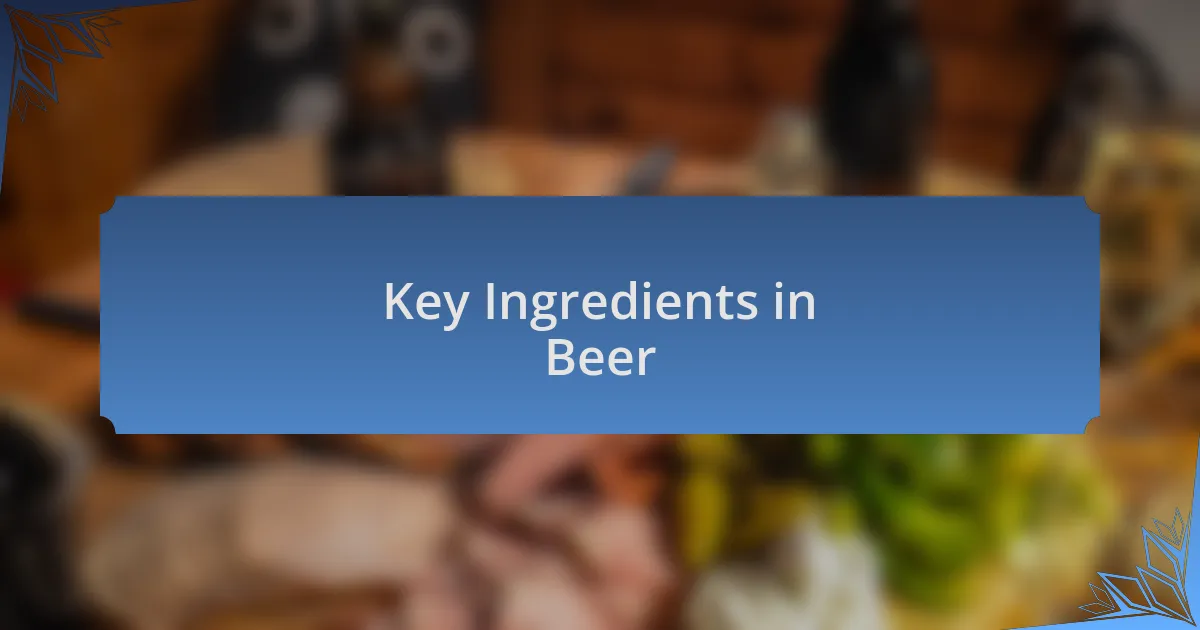Key takeaways:
- Craft Beer Festivals offer a vibrant atmosphere for sampling diverse brews and learning about the passion behind each craft brewery.
- The four key ingredients—water, malt, hops, and yeast—each significantly impact beer’s flavor, aroma, and overall character.
- Hops not only contribute unique flavors but also balance sweetness, while malt provides richness and complexity to beers.
- Exploring different beer styles can lead to surprising flavor experiences, broadening appreciation for brewing creativity.

Understanding Craft Beer Festival
Attending a Craft Beer Festival is like stepping into a vibrant world of flavors and creativity. I remember my first festival; the air was filled with hoppy aromas, and I was immediately drawn to the various booths. Each craft brewery has its unique story and passion, which makes sampling their beers feel intimate and personal.
One of the most exciting aspects of a Craft Beer Festival is the opportunity to learn about the ingredients used in each brew. I often find myself captivated by a brewer explaining the meticulous process behind their signature pale ale. Have you ever wondered how different types of hops can drastically change the taste profile? It’s fascinating to see how something as simple as a single ingredient can create a spectrum of experiences.
As you mingle with fellow beer enthusiasts, the sense of community is palpable. Sharing thoughts on the latest flavors or debating the merits of a stout versus a lager makes for lively conversations. I recall bonding with strangers over a particularly bold IPA, where we laughed, tasted, and even traded recommendations. Isn’t it incredible how beer can bring people together?

Key Ingredients in Beer
When it comes to beer, the key ingredients are like the notes in a beautiful symphony. Water, malt, hops, and yeast each play a crucial role, shaping the flavors and textures we love. I once chatted with a brewer who emphasized how the mineral content of water can alter a beer’s character—who knew something so fundamental could have such a profound impact?
Malt is another essential component, providing not only sugars for fermentation but also rich, complex flavors. I vividly recall tasting a robust porter that was brewed with a special roasted malt; it wrapped my taste buds in dark chocolate and coffee notes. Have you ever wondered how these flavors come to life? It’s all in the malt selection and the process, unlike anything I thought possible.
Hops, with their aromatic qualities, can add everything from bitterness to floral notes. I can’t forget my surprise during a tasting when I encountered a pale ale bursting with citrus flavors—each sip reminded me of biting into a fresh grapefruit. It truly highlights the magic of this ingredient. Isn’t it amazing how the right combination of these components can create a beer that resonates uniquely with our senses?

Role of Hops in Beer
Hops are often referred to as the soul of beer, and I truly believe this to be accurate. Just recently, I tried a New England IPA that showcased the enchanting array of hop varieties. Each sip delivered a wave of tropical fruit flavors, leaving me in awe of how these little flowers can transform a simple brew into a flavorful experience. Have you ever felt that burst of flavor and wondered just how hops manage to create such complexity?
Beyond their tantalizing flavors, hops also serve a crucial purpose in balancing beer’s sweetness. I remember tasting a well-crafted amber ale that had just the right amount of hoppy bitterness to complement its maltiness. It was a perfect dance on the palate, showcasing how essential hops are in the brewing process. Isn’t it fascinating how the bitterness can enhance other flavors rather than overshadow them?
Moreover, the aromas released by hops play a significant role in our overall drinking experience. I still vividly recall entering a brewery and being greeted by the floral, earthy scents wafting through the air during a hop addition. The anticipation of tasting a freshly brewed beer is unparalleled, and it’s all thanks to those aromatic oils. Have you ever stopped to appreciate the myriad of aromas that hops contribute to your favorite brew? It’s these sensory experiences that truly bring beer to life.

Importance of Malt in Beer
Malt is the backbone of beer, providing not just sugar for fermentation, but also contributing layers of flavor and aroma. I remember sipping a rich stout, and I could distinctly taste the chocolate and coffee notes that come from roasted malts. It made me realize just how integral malt is, transforming simple grains into a complex ingredient that enriches the entire brewing experience. Have you ever considered how your favorite beer’s character is shaped by the specific malts used?
The variety of malts available is astounding, each offering a unique profile that can change the beer’s color, taste, and even mouthfeel. For instance, encountering a beer brewed with caramel malt was a delight; it introduced a sweetness that balanced perfectly with other components. It’s like crafting a symphony, where every malt plays a vital note, creating a harmonious and pleasurable drinking experience. Isn’t it intriguing how a choice as fundamental as malt can redefine the essence of a beer?
Moreover, the process of mashing, where malt is soaked in hot water, is where the magic truly unfolds. I vividly remember visiting a local brewery and witnessing the mash temperature carefully adjusted to extract different flavors. The brewer explained how this step not only impacts sweetness but also the body of the beer. It struck me how something so technical can lead to such rich sensory experiences. When you take your next sip, consider the journey that each malt has undergone to become part of that glass.

Exploring Yeast Varieties
Yeast varieties are fascinating because they play a crucial role in defining the character of beer. I remember a time I brewed my first batch using a classic ale yeast strain. The aroma that filled the room was intoxicating, a blend of fruity esters and slightly spicy notes. It made me appreciate how even a small change in yeast can lead to completely different flavors—have you ever noticed how a simple switch in yeast can take a brew from ordinary to extraordinary?
Different yeast strains can really bring out diverse traits in beer. I’ve explored Belgian yeast, and oh, the complexity it adds! It imparts a lovely banana and clove profile that transforms a simple wheat beer into something special. Each time I taste a beer with a unique yeast contribution, it feels like a journey through the brewer’s creativity. Isn’t it amazing how something so tiny can have such a profound impact on our experience of beer?
Furthermore, the fermentation process is where yeast truly shines. I recall watching a fermentation tank bubble excitedly, and it felt almost magical. As the yeast consumed the sugars and released carbon dioxide, it was clear that this transformation was vital. Have you ever wondered what’s happening behind the scenes during fermentation? It’s an intricate dance, revealing just how alive the brewing process is. Each flavor profile crafted by yeast varieties tells a story that deserves to be savored.

How Ingredients Affect Flavor
There’s something incredibly rewarding about experimenting with different malts in brewing. I distinctly remember the first time I used smoked malt; the rich, campfire aroma enveloped my kitchen, and I couldn’t help but get excited. It was a clear reminder that malts can introduce a whole palette of flavors, from caramel sweetness to deep chocolate notes. Have you ever discovered a new favorite beer and traced its essence back to a unique malt? That’s the magic at play, where each grain contributes to the beer’s identity.
Hops, on the other hand, are like the spice of the brewing world. When I first added Citra hops to a PA, the burst of citrusy notes surprised me. It was like biting into a ripe grapefruit, balancing perfectly with bitterness. I think it’s fascinating how different hop varieties can create entirely different profiles—some are floral, while others are earthy. Don’t you love trying to pinpoint the hop flavors in your favorite brews? Each sip becomes a delightful puzzle, challenging our taste buds while enhancing our appreciation for the craft behind each pint.
Water chemistry is often an overlooked aspect that profoundly influences flavor. I’ve dabbled with adjusting the mineral content of my brews and was amazed at the difference it made. A subtle shift in calcium or sulfate levels can transform a beer’s mouthfeel or brightness. How often do we consider the role of water when we sip? It’s a vital component that shapes our drinking experience, yet it’s rarely given the spotlight it deserves. The more I learn about these interactions, the more intricate and beautiful the world of brewing becomes.

My Discoveries from Beer Tasting
Tasting different beers has opened my eyes to how intricately flavors intertwine. I vividly recall savoring a Belgian Dubbel for the first time and being captivated by the fig and caramel notes that danced on my palate. It made me wonder—how can one beer evoke such a vivid tapestry of flavors? This experience deepened my appreciation for how brewing techniques and yeast strains affect the final profile.
In another tasting session, I had an unexpected revelation with sour beers. The crisp tartness of a Berliner Weisse left me both intrigued and slightly bewildered. I didn’t think I would enjoy something so tangy, yet it was refreshing and perfect for a sunny day. Have you ever taken a leap of faith with a beer style outside your comfort zone? That moment helped me embrace the idea that the world of beer is full of surprises, encouraging us to explore beyond our usual choices.
The joy of discovery also comes from recognizing the subtle nuances in aroma. I clearly remember sniffing a brew that boasted hints of pine and resin. It triggered fond memories of hiking through a dense forest, surrounded by towering evergreens. This sensory connection reminded me that beer tasting is more than just about flavor; it’s an avenue for revisiting cherished moments and evoking emotions. Isn’t it fascinating how a simple sip can transport us to places we hold dear?